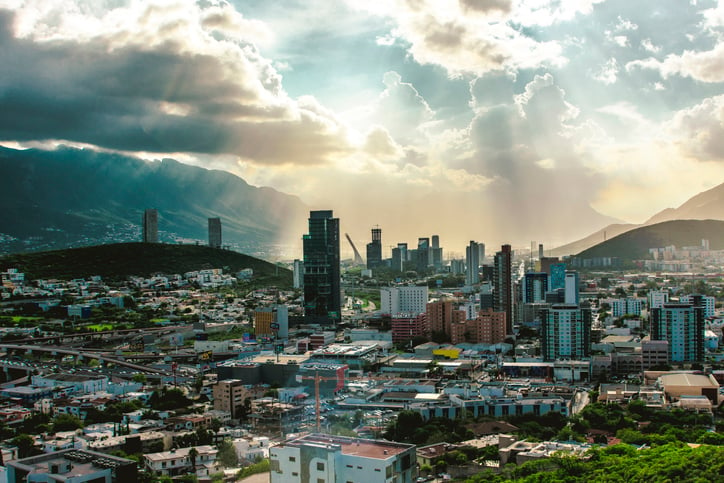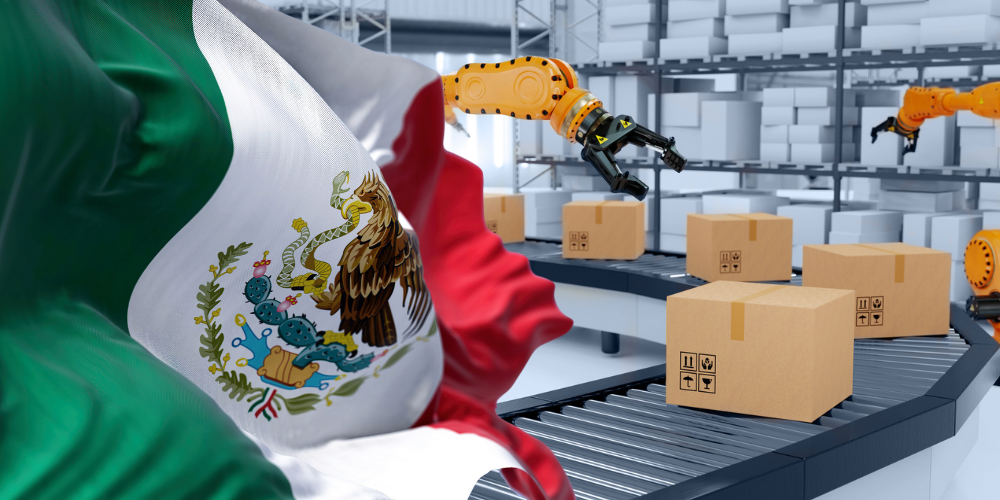Below is a transcript of the above presentation we presented at a Mexico Manufacturing Symposium in May of 2023:
Thank You guys for coming out, just to hear about, how Mexico might be able to be a, a strategy that you guys can use, in your manufacturing environment. And so my name is Troy Patterson. I'm the President and Founder of, Visigistics. And we work with, manufacturing and, distribution companies. We, we put together, we do supply chain consulting as well as, logistics solutions for companies.
And, you know, over the last, three years, we've heard kind of a similar theme over and over, and that customers are frustrated with, or companies are frustrated with rising costs, rising transportation costs, material costs, labor costs.
They're upset about the disruptions in their supply chains and how that's impacting their business and their ability to, meet their demand for their customer. And quite honestly, they're concerned that there's other options or other, other things on the horizon that may impact their business coming forward.
I don't know if that resonates with anybody about what there is? I see some heads nodding, but, you know, so we're, we're going to talk a little bit about today that the world is changing right now. I mean, it is changing, it's changing at a breakneck speed. And so I'm going to just walk us through, we're going to look at, are your supply chains adapting with it? And we'll give you at the end of this kind of a tool framework that you guys can work through as you look through it. And then, you know, I'll jump to kind of, the end solution.
We believe that reshoring and nearshoring is a great strategy as we move forward to help to avoid some risk. So let me make sure that my clicker's working here. There we go. So I'm going to walk us back a little bit.
Take you guys on a journey going back to 2018. So new administration wants to kind of create some, require China, let's just, we're going to implement tariffs in against the Chinese because they haven't opened up their markets and really want to try to move towards a fairer trade situation and protect the, the American workers, so the American jobs. So we started ratcheting up these, tariffs.
And we end with, in June, January of 2015, oh, sorry, January 15th, 2020, we ended with what they called the phase one agreement, which was the 301 tariffs that were agreed upon and put in place. And so what happened right after that?
Does anybody remember something called covid? Right? So we have this thing where we start shutting down the economy and shutting down jobs, and it really started to change the way that we worked, lived, and interacted with people, right?
And so we have this event, and then we start having disruptions and then we have an impact to our supply chains. And so we had this run on toilet paper, you know people were, I guess were concerned that, well, I'm not going to go at the office, I got to go at the house. And so we're going to go and, and do this, but we changed how we worked, lived, and interacted with each other through this event. Well, then what happens, right?
Well, we're going to pay people to stay at home and the government starts pumping money into the economy. And so now we've got people, we've got this event that happens. We've got people that are now sitting at home and they got money to spend. And so we start to see this, this economy starts to grow in a way where we, we have this tremendous demand, but we're also, at the same time, we've got issues because we have people sitting at home and they're reflecting on, do I really like my job?
And we start having this great resignation. We also required people, hey, if you come in contact with somebody who tests positive for covid, you've got to stay at home. So we've got people that are required to stay at home for 10 days, and we've, we've kind of decimated our workforce through this process here.
Whoops. I'm going to and then anybody remember, the great snow and freeze in February of 2021?
Does, does anybody recall what impact to the supply chains that had? I mean, obviously, it was, you know, we were shut down for like a week where the whole state was frozen, but this had a huge impact on the global plastics market. Why? Because the refineries were shut down, and the, companies that make the resins from the refined oils were shut down and it took months.
We have a, we have a customer that they sell a polyethylene pipe and they didn't get back to normal until November. So this was like a nine-month process to go and recover from a week of shutdown.
Well, the next one, does anybody remember this one?
Yeah, y'all saw pictures of this, right? So we have this huge demand and a lot of people, anybody want to go and say, hey, we bought more product because we saw this demand and we wanted to hedge against risk by bringing on more, more product. So, that happened. So here's a picture of what this looked like along the coast. And the reality is the bottleneck wasn't offloading. It wasn't offloading the ships. It was that it was that we had problems, let, let's call it in California.
They had a policy, a state policy that said you couldn't stack more than two containers high. They also limited the number of trucks based on their, their it had to be, a certain age or less or newer that could actually service the ports. And so we caused issues. Well, this was not a good picture for the new administration.
So hey, what we're going to do is we're going to start offloading these ships. And then we had a problem. Again, we talked about people getting sick or coming in contact with people. Well, the railroads didn't have the capacity to move it. And so is there anybody here that was using the rail during that time that was impacted by this? We had a customer that we were really encouraging to go through the Port of Houston and Transload, and he is like, ah, just send it via the rail, it'll be fine.
We got stuck for 60 days outside of Chicago because there wasn't the capacity to move it so well, what was the next thing? Well, people bought more product than they needed. And there's this, there's this thing called the bullwhip effect, which is you start responding to demand, and then by the time you are able to see that your demand is waning, you've already bought too much product.
And so this is an area where we're seeing right now, things have slowed down and companies have, have got excess inventory because the economy is slowing. And so the warehouse guys are, are making a lot of money. How about this, the risk of strikes? Do y'all remember this? So this, this, again, it feels like ages ago, but it was just December. So we have these the railroads were on under, not under a contract for two years.
And so they started ratcheting up, they voted to approve a strike, and then there was arbitration and then there was, there was multiple rounds. And so we got to the end and it was dec I want to say it was mid-December, right before Christmas. And the current administration basically said you know, the Biden administration said, you can't, you can't go and strike. And they forced an agreement that they're still kind of working through, but that was a risk for disruption.
Well, the port workers in LA are still working without a contract right now. So the longshoremen, actually LA along the west coast are working without that. And we saw a little bit of disruption over Easter, where I think that was just a little flex show of a little force where they said, Hey, we're taking Good Friday off. And so that caused a little bit of disruption.
How about the next one? Do y'all know that UPS is currently in contract negotiations? So maybe some stable rattling here, but they're, they're saying that they're not afraid to strike. And so we don't know what the impact of this might be, but it's just amazing how all these things are coming together. And then, did y'all see this one?
So this was just last week. American Airlines pilots authorized a strike.
Here's why you shouldn't panic. Oh yeah, thank you. All right. <laugh>, Southwest Airlines is in a similar situation they're working through their, pilots agreement right now too. So we still have a huge amount of risk of potential disruption because of, challenges or, or negotiations that are going on with some key aspects of our, our supply chain infrastructure, our logistics infrastructure.
So here's the other thing, right? Rising inflation. We are all affected by this gas, food, and groceries. My energy bill this last month was crazy. But, we have a tremendous amount of inflation going on year over year, and that causes an impact to how do we stay ahead of this? How do we make sure that we're doing the right thing for our customers and for our business? This was a headline just last month, just 30 days ago in Connecticut.
A big mac, fries, and a Coke will cost you just about 18 bucks up there. I don't like Big Macs that bad, that much. I don't know about you, but I kind of look at, man, if I got to pay 18 bucks, it better be good. But I, I guess I'm glad I live in Texas.
So we've, we've been through a lot.
I mean, we've been through a lot of change just over the last three years. Would y'all agree?
Yeah, we've been through a lot. The question is, what's next?
So I, I'll say these are headlines coming up that are recent. I don't know the impact of them, I'll say that right now, but I see the world is changing. And so I know that if the world is changing, then I need to be working with my clients to help them adapt to new strategies and figure out what might we do to at least hedge some of this risk.
We got some bankers in here, right? Silicon Valley Bank. This was what, five, six weeks ago. I got, I got a call from a client on a Saturday morning. I've been trying to get in touch with him, working on a couple of things. He calls me. And he said, Troy, he said, I've been busy. Yesterday was the second worst day I've ever had in my business career. And I go, well, I don't want to know what the first one.
I go, why? And he said, we had just moved to Silicon Valley Bank three months ago, and all that money's gone. Now, the good aspect of it is, is okay, we now know the rest of the story. They were able to go and, and work through that I guess folded the bank under something else, but he was just kind of, he wasn't distraught.
I was surprised at how well he was taking it and what plans he were made. But this was, this was scary for him. This was real scary. Well you know, the fed raises rates, well, what happens? The fed raises rates. The increase of the interest decreases the yield of the bond. These regional banks, we pumped a bunch of money into the economy, they had to put somewhere to invest it, right? Bankers, where, where my bankers in the, in the room, right?
Well, these guys had gone into 10-year bonds and, and then we also have an accountant right in the room, the mark to market, right? When the bond, when the interest rate goes up, the yield of the bond goes down. And so the value of the bond goes down. Unless you're holding it to maturity. These guys were not in, a liquidity issue.
They were in, a balance sheet issue where they've got to maintain some liquidity issues. So what we've had, what I think three regional banks recently come through we've got a lending slump because of it. Businesses are not really wanting to take the risk, of doing this. And then remember I said that Covid changed the way we worked, lived, and interacted with each other. Well, what companies are now seeing with this remote work is they don't need the footprint in their commercial space as much.
And this is going to take some time to work out. But these, as these leases are coming up over periods of time, companies, big companies, small companies are looking to shrink their footprint because people are, they're not needing it as much. And so a lot of those buildings have some kind of financing against it. So we've got a real issue there.
I also saw an article this week that I didn't add that the subprime lending for auto loans is going to have a big issue because people are not able to make those car payments. And so there's going to be lots of repossessions in that secondary subprime auto loans this was just last week, so this was Thursday, right? Regional banks stocks get hammered mainly because the PAC West issue that, that you know, it looks like they're, I haven't followed that story directly, but you know, there's issues because of these long-term bonds.
All right, let's see here. So we also have some things going on foreign, right? So Deutsche Bank was the largest bank in Germany recently. They were having, some financial struggles and then got bought by U P U B S. Anybody know about bricks? What does, what does anybody tell me what brics stands for? What's the beef? So, Brazil, Russia, India, China, South Africa, right? So what they have done is kind of created an alignment.
So it's, we're starting to see an east kind of versus west alignment and, and they're creating an alternative banking system. And I read an article I think it was last week, maybe it was two weeks ago, that the bricks nations have eclipsed the g p of the G seven economies. And so we're starting to see some, some alignment or some challenges there. And then I saw this headline, bricks is expanding to go after Saudi Arabia, Indonesia, and behold beyond holds promise, but challenges remain.
Why is Saudi Arabia important? Does anybody know oil? What, have they been transacting in their oil in US dollars, right?
So history lesson back in the seventies, I think it was 73 I think it was France, we were on a gold standard. Nixon, France wanted their gold. Nixon said no, we immediately removed off the gold standard and then went directly to Saudi Arabia and said, we want you to nominate your oil in US dollars in exchange we'll provide protection for Saudi with the US military.
So that's been in place for what, 50, 40? Yeah, almost, almost 50 years. 50 years now. Yeah, 73 to 2023. And now we're starting to see Saudi Arabia move away from only doing transactions in oil in the us, in US dollars. So and then Macron, recently met, with China, and after that meeting, he, he made this statement, it says, Europe should reduce dependence on the US dollar and seek "strategic autonomy".
I don't know what strategic autonomy means, but I understand what he says. We should reduce the dependence on the US dollar. And so there are things changing in the monetary system in front of our eyes. I don't know how it's going to play out, but I see it happening.
So here's another one. I don't know if y'all seen any, any articles around de-dollarization. Well, this is an interesting article that says that the bricks currency will feature significant gold backing. So the US dollar is backed by what the full faith and credit of the United States government, whatever that means.
Okay? But that's starting to wane. So now we're starting to see articles about, hey, central Bank digital currencies are coming, whether countries are ready or not. So we're starting to see, again, this east versus west, the bricks versus the central western central banks.
This concerns me because this is not currency, it's software. And so what can you do with software? Is whoever is writing the programming gets to make the rules. And so that concerns me. Well, I think it also concerns some people in the Texas legislature, because recently, this was in March that there was a house bill in the Texas State House and in the Texas State Senate that were introduced into committees to actually allow Texas lawmakers to consider the launch of a digital gold back.
Or it's actually in precious metals back currency. So back in 2017 some of you guys may know this or may not Texas created a Texas bullion depository. Does anybody know about that? So the state government said, hey, the University of Texas and Texas A&M had like 600 million in gold that's stored in, in New York. Why are we storing our gold in New York?
So they passed a law that allowed that to create a bullion depository, and it's, I think it's in Dripping Springs or somewhere near Austin. And what was interesting about this is that within the law, it allowed for banks, I don't know if you bankers realize this, it allows for banks to be agents of the depository. And so it allows for retail banks to actually be able to do this.
Well, when tied up with this law, now we've got the ability to deposit gold, silver, and other precious metals through a retail banking center. And the way I read this is this is going to be some kind of blockchain-backed technology that allows transactions to potentially happen in a so a sound money type environment with, tell 'em I'm busy <laugh>.
And, and so it's, it's, it's interesting as we see this unfold, what might happen.
So then what happened in the United States Congress is three congressmen went and submitted another bill to introduce that. I have no thought that that would actually pass at this point in time, but it's interesting is, hey, we want, we see that there's inflationary pressures we want to remove to a sound, we want to move to a sound money type background. And the next one, right?
So China, I got a lot of them here.
Lemme see, how am I doing on time? All right, I got five minutes. All right. So China here is, has been moving to push their one and the transactions that are happening. And this is just saying this is starting to add up.
And last month the dollar fell behind the Yuan in cross border Chinese trade. So Chinese had done more business and trade in the Yuan than they had in the US dollar for the first time last month.
And then I went and looked at the update on this, the bill on the gold, gold silverback transactional currencies that is in the House has actually moved out of committee. It got passed out of committee is now being waited to vote on the floor in the House. It's still in committee in this Senate. So this is interesting because if it does pass, then that law would go into effect on September 1st of this, of this later this year.
Now that doesn't mean that you'd have that currency there, but it does put all, the things in place to where that could happen.
So that'd be interesting. And then the last part, we have geopolitical stuff. And so I'm going to go through this because I know my, my time is running pretty short here. But what were some of the supply chain impacts of the Russia-Ukraine issue?
Can anybody tell me? Steel. Steel, okay, what else? Wheat, wheat crops, natural gas, fertilizer. Russia is the number one producer of fertilizer. How about neon gas in Ukraine? What's neon gas used in chips? Chips, right? So we have this huge issue with the supply chain coming out of, out of this deal. I, I won't go through all this, but you can see that we've got this, this rising conflict, Russia, China, Iran doing exercises, right?
So China has this goal of having a unified China. They developed a plan in 1949, a hundred-year plan. So these guys, we think in quarters, they think in quarter centuries kind of deal, right? So they're thinking a hundred years out. They put a hundred-year plan in place. Some of it's declassified on the internet, but they want to be the world leader by 2049. And so we're starting to see some of this conflict start to play out.
Well, the problem is, if they want to be the world leader, what does that leave us? It leaves us the people they're going after. And so if we look at this kind of holistically and, and, and objectively China has been quite honestly a Trojan horse, right? We've sent our money, we've sent our jobs, we've sent our intellectual property we've sent knowhow and what have they done?
They've invested in our own businesses. They've, you know, technology they've built a tremendous navy out there. And so they're long game. So this is a book. So the title here, Danger Zone, The Coming Conflict with China goes into detail, right? So there are a couple things with China, their single-child policy is coming back to haunt them. There are 40 million more marrying-age men than there are women. And so you have a declining workforce over there, but they've got this power.
And so they've got to kind of expand to be able to have those resources. They, they, they're s the pollution causes problems with their ability to generate food. They have energy shortages. And so we, we see this potential coming conflict that we hear about with Taiwan and all of the, the, the tabletop exercises and articles that I read is that if there is a kinetic war, it's not a disruption.
The movement of goods out of Asia stops, right? So that, again, I'm not saying that's there, I'm just saying that this is a risk as we're building through this, that we need to start looking at. Like, if we get to that point, it's too late because moving manufacturing back to the United States or to Mexico is a process, not an event. And so it will take time to move those supply chains. So this is just kind of a primer.
So what can you do? All right, so my, my takeaway here, and I've got one-minute left cause I'm going to keep us on time. The takeaway here is what can you do? So in the short term, do a SWOT analysis. Go through these categories, right? And if you need some more prompts, man, what does our supplier base look like? Does our, does our suppliers, are they manufacturing it in, in the United States? Or what kind of components are they sourcing out of China? What kind of risk do we have?
What do they source from? And what does that second, third tier look like? You know, what other profitability or services? So later today, we'll be able to hear from a use case on how could you go and differentiate your product and it not just be on cost and provide value in the marketplace.
Do you have the right partner in logistics? How good are you at planning? You know, what are the tools that you need to add and invest in, right? You know, are you measuring the right things? These are the short-term term, you know, what about governance, right? And then what are the near-term plans and then the long-term plans that you need to put in place? And again, from a manufacturing perspective, we, you know, one of the challenges with manufacturing in the United States is I think there needs to be some policy changes.
There needs to be some incentives, some tax changes. And we've done, we've created with some of the challenges with EPA and all that stuff, and I'm not saying we don't want clean air and water and, and stuff like that, but we've put a burden on the United States businesses, which made it easy to go somewhere else.
So this is just a framework. We have a little e-book that if you want, is that be glad to, to take a look at this and download it. And it's just about how Mexico is disrupting Chinese manufacturing.
So we believe that there's going to be hundreds of billions of dollars of product moving out of Asia back into North America over the next 10 years. Barring any major catastrophic you know, conflicts.
But just, just because of this, because we believe that this, these conflicts will continue to rise. So with that, I'm going to go ahead and introduce our next speaker. Let me get this real quick and get you up and running here, Jeff.





